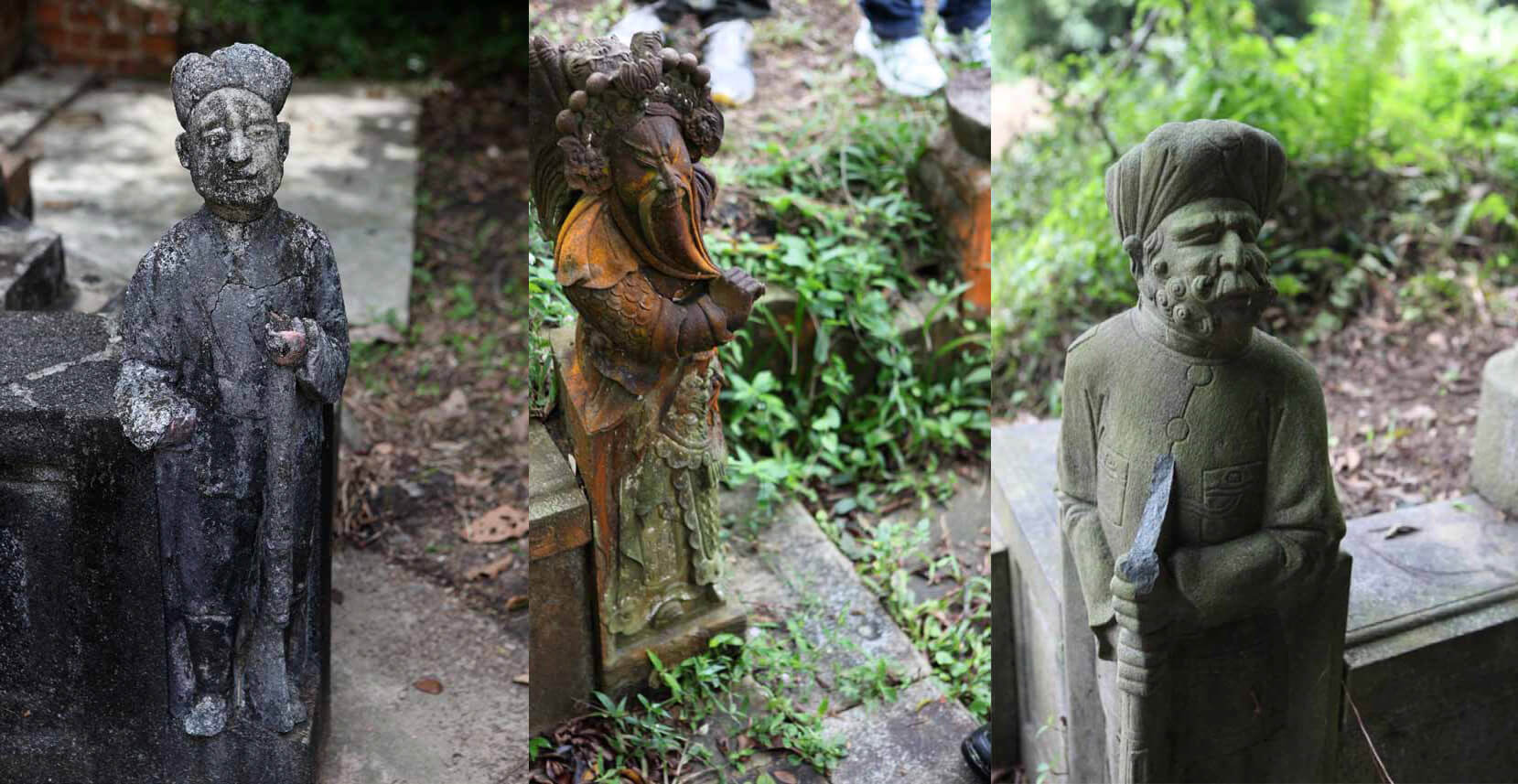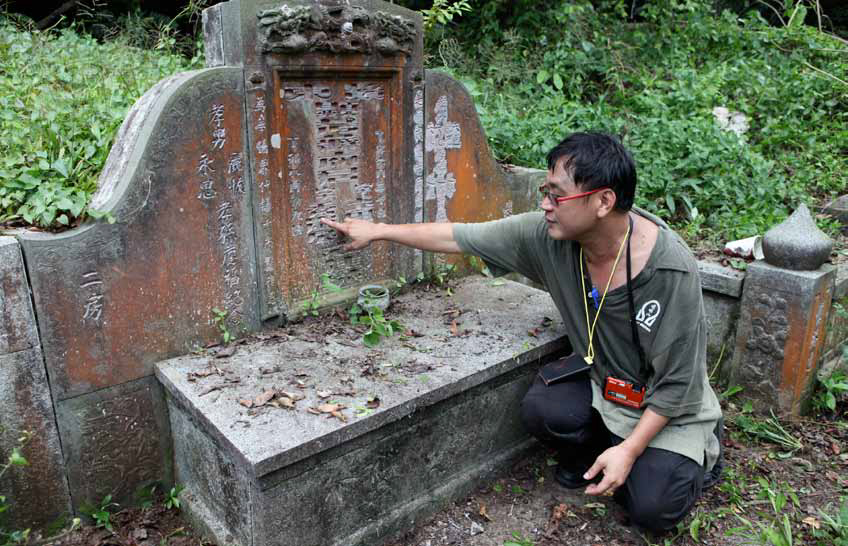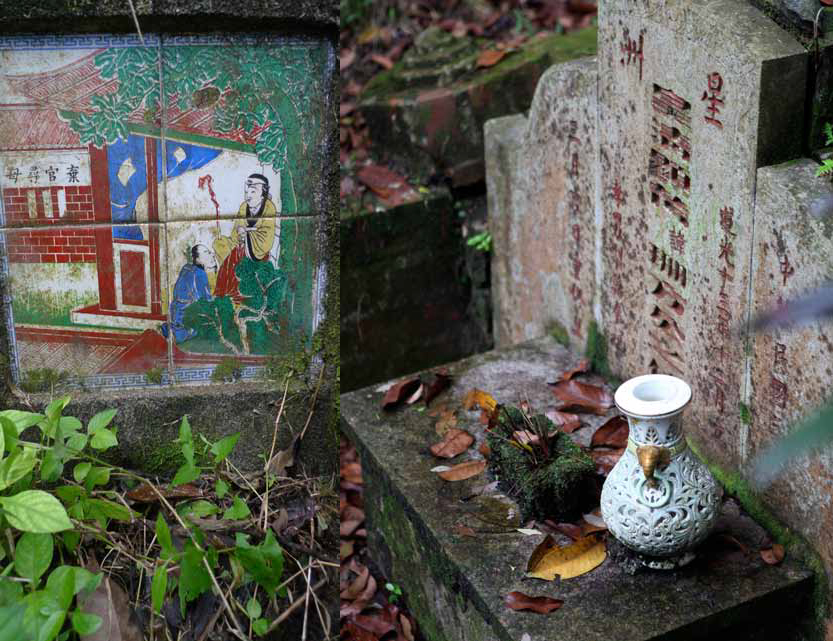
In post-election Singapore, no issue has touched as many nerves as the government’s plan to develop Bukit Brown Municipal Cemetery for future housing, paving the way with a mass transit station and a proposed highway. It covers hotly debated policies, such as housing, transportation and immigration and touches on quality of life considerations. In the boom and bust of the last decade, including a peek into the abyss during the Great Recession, a sense of vulnerability and crisis of identity also surfaced.

Historical researchers found this unique tomb of two brothers who were part of the Tongmenhui, and Kuomintang, underscoring Singapore’s role as Chinese diaspora helped Sun Yat Sen in his goal for a republic, ending dynastic rule.

Intricate carvings speak of a craftsmanship no longer seen in modern Singapore, portraying moral fables and Chinese legends.
The plan for developing the greater Bukit Brown area, located dead centre of Singapore, was first announced in a Concept Plan in 1991 to little fanfare in a different era where government decisions were not disputed. Two decades later, on May 30, 2011, a detailed announcement by the Urban Redevelopment Authority (URA), Land Transport Authority (LTA) and National Heritage Board (NHB) to designate Bukit Brown for residential use had quite a different effect. The electorate was emboldened by the changing political climate: in the May 7 general elections, the ruling party’s share of the vote dropped to a historic low of 60.1 per cent with the loss of some heavyweights including the foreign minister. More crucially, alternative views were increasingly aired and shared in the social media. The months following the election saw growing public dissatisfaction over quality of life issues due to higher costs of living, particularly in the area of public transportation where the public faced higher cab fares and multiple subway breakdowns. The controversy highlighted deficient communication not only between the government and the governed but also between government agencies. On a deeper level, it cast the government as fallible and open to criticism.
Against that backdrop, on September 12, the Land Transport Authority (LTA) announced plans for a proposed eight-lane highway through Bukit Brown. It’s worth bearing in mind that the URA was still reviewing its long-term plans in the Concept Plan Review: 2011 when this decision was announced. A highway seen to benefit private car owners touched more nerves.
It is instructive to look at the level of transparency and quality of consultation when the LTA made the announcement. According to the Singapore Heritage Society (SHS), “the reality” of the consultation process underscored that these processes are used to inform civil society and relevant stakeholders of decisions already made, and not to engage in serious discussions. The purpose of the consultation was “to manage public opinion and to tap on SHS’s network” so that the graves to be exhumed could be documented. SHS said the decision “was relayed privately to a senior member of SHS” just two weeks before the public announcement, hardly time for a serious debate over alternatives. On November 6, after weeks of controversy, Minister of State for National Development Tan Chuan Jin, in an interview with the Straits Times acknowledged, “we could have done better… maybe get more stakeholders and earlier.”
Seeking to engage
The desire for greater engagement persisted when the SHS and the Nature Society (Singapore) (NSS) convened a symposium on Nov. 19 to debate the issues concerning Bukit Brown, from heritage to hydrology. The NSS led the way by analysing the biodiversity, having identified Bukit Brown as one of 28 sites for nature conservation since 1990.
The 233-hectare area, which also covers nearby cemeteries Lau Sua, Kopi Sua and Seh Ong, is home to 90 resident and migrant bird species, 23 per cent of Singapore’s bird species. Thirteen are nationally threatened such as the red jungle fowl and the white-bellied woodpecker. It also identified 48 forest species, almost half Singapore’s total in such a small area.
The NSS presented these findings together with alternative road options to the government on Dec. 12, 2011, saying, “many of our brightest minds and most passionate individuals when working together can make Singapore even more special.” Its appeal was “for the increased quality of life … from safeguarding and celebrating nature.” It argued that finding alternative transport solutions “can be a challenging engineering opportunity that could showcase the talent of Singapore, and set a benchmark for Asia in sustainable development.”
The SHS presented its position paper in January 2012, calling for a scrutiny of the heritage value of areas affected as a standard operating procedure, not an after-thought, and recommending greater transparency. It attached two appendices, one acknowledging the historical debates over the cemetery as a contested space, by Terence Chong, a sociologist and senior fellow at the Institute of Southeast Asian Studies at the National University of Singapore; and the other a study of hydrology by Lim Han She, an assistant professor of geography at the same university.
Lim’s article notes that Bukit Brown is covered by relatively mature vegetation essential for soil protection and as a catchment to prevent flooding, touching on another topical issue. Chong’s article touched on something more intangible—the intrinsic value of the cemetery as a place of identity.
While discussion of Bukit Brown in the public domain is couched in terms of a difficult but necessary policy for the dead to make way for the living, those in support of its historical significance argue that the cemetery represents a link to a storied past for the living, whether descendants or citizens of an immigrant society that by extension benefit from an understanding of Singapore’s history of immigration and war travails.

(left) Some tiles depict morality tales.
(right) The tomb of Fang Shan, a coolie who died in 1833 and was re-buried there by the Fang clan. His headstone features the word “Sing Chew”—the early name for Singapore.

A tombkeeper, some of whom bear oral history of a different time,
including the mass dumping of bodies during the Japanese Occupation.
Contested spaces
“The compulsory acquisition of Bukit Brown” from the Hokkien clan association, which used it as a clan cemetery, to become a municipal cemetery from 1922 “was seen as the prying open of a private space layered with social ties and symbolic networks found in clan association which fostered a strong sense of ethnic belonging,’’ writes Chong.
He called the acquisition ‘a challenge to identity’. Needless to say, nine decades and more than 200,000 burials (in the greater Bukit Brown area) later, that sense of belonging has only multiplied across ethnic lines, as a growing Chinese diaspora, colonial rule, flourishing trade, two world wars, Japanese occupation and independence added to the layers of networks, history, evolving culture and societal norms.
Singaporeans today who lament the development plans also raise the question of identity in a young nation with few heritage touchstones being challenged. History, it appears, is repeating itself. While discussion of Bukit Brown in the public domain is couched in terms of a difficult but necessary policy for the dead to make way for the living, those in support of its historical significance argue that the cemetery represents a link to a storied past for the living, whether descendants or citizens of an immigrant society that by extension benefit from an understanding of Singapore’s history of immigration and war travails.
The NSS and SHS, with other interested civic groups, approached relevant government agencies—the National Parks Board, LTA and URA—in early 2012 to further the discussion in the hope of a compromise. On March 19, the LTA announced a new alignment for the proposed highway. Hours later Minister Tan met the two societies and selected invitees to a briefing. The episode exposed the expectation gap between the government and civil society. The latter issued a statement expressing disappointment at the lack of genuine engagement, asking for a moratorium, while the Minister used social media to post a Facebook comment that the briefing “was never intended to be the type of dialogue desired” as “it was not a consultation effort to debate” the issue.
It elicited a response from a reader. “Citizenship is not only a right,” Joseph Chun, wrote. “We have a duty to ourselves and to each other as citizens and to future generations of citizens to ask to see and scrutinise for ourselves the facts and projections asserted by the government to justify its decision to build this road, and after that to ask each other as citizens if this is what we really want for our country.”
An inclusive society
Some argued they were not against the decision per se, but how it was reached almost unilaterally. Tellingly, it was in social media space and not in the mainstream media that the frank opinions were aired. Closer scrutiny would have shown the key stakeholders consulted were other government agencies. Nonetheless civil society carved a place for itself.
It was amateur historian Raymond Goh who on March 4—coincidentally the 70th anniversary of the end of the Sook Ching massacre of the Chinese under the Japanese Occupation—found the possible location of the communal trenches where the war dead were buried by the truckloads. Other volunteers trawled through burial registers and sought out elderly tomb keepers for eye witness accounts. The information was duly passed to the documentation team for confirmation as the suspected trench falls in the boundaries of the proposed highway.
Bukit Brown is a physical manifestation of a storied past that lays bare the multi-ethnic roots of Singapore’s identity and her place in history. Among the volunteers, the Chinese-educated help the non-Mandarin-literate Peranakans (Straits Chinese or Indians who speak Malay) to study tomb inscriptions. Former Malay villagers help provide oral history of the defunct Kheam Hock village nearby. An Indian Sikh is exploring the history of Sikh guards in the Chinese community. The three roads that lead to the rusted cemetery gates bear the names of three ethnic groups. Whether it is educational tours to raise public awareness of Bukit Brown as more than a cemetery but a place of historical significance, or respect for it as a battlefield for fallen soldiers and mass war graves, civil society and the community could enrich, not diminish, the debate for the greater good. In the process, they add another layer to the pursuit of identity.
Claire Leow is the founder of the educational blog, all things Bukit Brown (http://bukitbrown. com)